General
What Is the Salary for Motion Graphic Designer? A Comprehensive Overview
Overview
The salary for motion graphic designers is influenced by several key factors, including experience, geographic location, and industry.
- Entry-level positions typically earn between $35,000 and $45,000.
- Senior roles in major markets can exceed $100,000.
This significant variation underscores the importance of understanding market dynamics. As the demand for animated content continues to surge—particularly in advertising and digital media—the earning potential for skilled designers is poised to rise. This trend reflects the increasing value placed on their expertise within the job market, highlighting the need for professionals to stay abreast of industry developments and enhance their skill sets.
Introduction
In the dynamic realm of visual storytelling, motion graphic designers emerge as pivotal figures, seamlessly merging creativity with technology to engage audiences across diverse platforms. These adept professionals convert static images into vibrant animations, enriching narratives in film, television, and digital media. As the appetite for compelling video content escalates, particularly within marketing, it becomes imperative to grasp the role and significance of motion graphic designers.
This article investigates the essential skills necessary for success in this domain, examines salary trends and the factors influencing compensation, and underscores the increasing relevance of motion graphics in the digital landscape. Ultimately, it illustrates why this profession is not only financially rewarding but also crucial in shaping brand identities and enhancing consumer engagement.
Understanding the Role of a Motion Graphic Designer
An animated visuals creator is a creative expert dedicated to producing animated visuals and visual effects across diverse media, including film, television, and digital platforms. By seamlessly combining design principles with animation techniques, these professionals craft captivating content that significantly enhances storytelling. Utilizing sophisticated software such as Adobe After Effects, Cinema 4D, and Adobe Premiere Pro, animated visuals creators transform still images into dynamic representations that effectively capture viewer interest.
In today’s marketing landscape, animators play a crucial role. Their contributions are particularly impactful in advertising; studies reveal that 35.1% of marketers assert that animation aids in better visualizing concepts, thereby enhancing audience engagement. As we approach 2024, the visual design sector continues to evolve, adapting to technological advancements while prioritizing inclusivity and sustainability—further underscoring the significance of animated design.
The average annual salary for motion graphic designers in the Northwest Colorado nonmetropolitan region stands at $71,840, highlighting the economic opportunities within this sector.
At WonderEight, we recognize the growing importance of animated designers in marketing, with projections indicating significant growth in 2025 as brands increasingly leverage animated content to convey messages and evoke emotions. Successful projects, such as our extensive campaign for Quaker Oats, exemplify how strategic visual design can strengthen brand connections with target audiences, resulting in enhanced brand loyalty and expanded market share.
Industry leaders emphasize the importance of animated design in digital media, noting its ability to improve viewer engagement and retention. As Farzeen articulated, “35.1% of marketers agree that animation helps them better visualize concepts. I concur. It is indeed a powerful tool for aiding the audience in visualizing concepts more effectively.”
As brands continuously seek innovative methods to distinguish themselves in a saturated market, the demand for skilled visual artists will only escalate, making their expertise a vital asset in marketing and advertising. Essential competencies for visual creators include proficiency in CAD, desktop publishing, image editing, video production, and web development applications—all critical for success in this dynamic field.
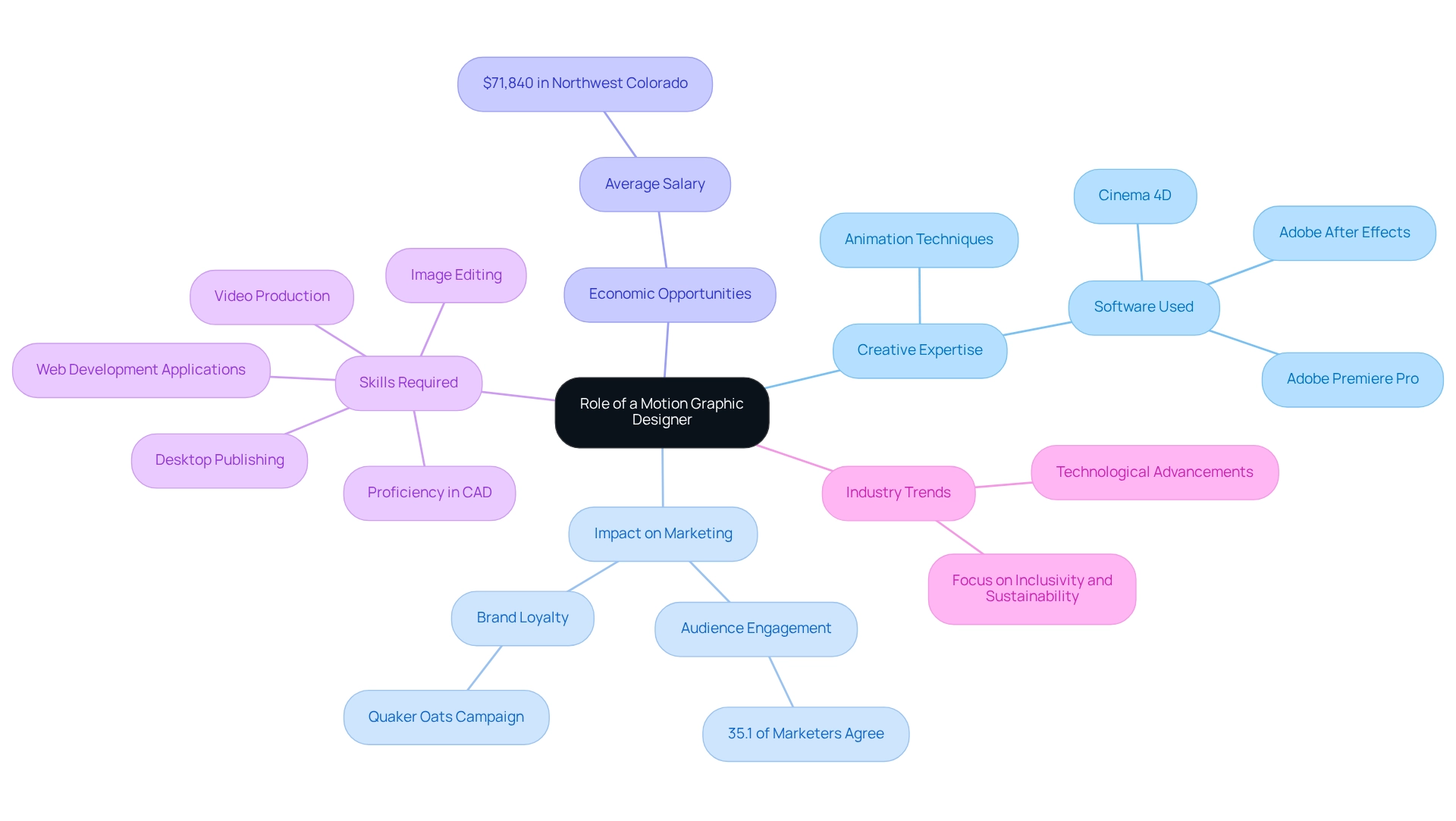
Essential Skills and Qualifications for Motion Graphic Designers
To excel as a visual artist, one must cultivate a unique fusion of technical proficiency and creative flair. Mastery of industry-standard design software—such as Adobe After Effects, Illustrator, and Photoshop—is essential. Equally crucial is a solid understanding of animation principles, typography, and color theory, as these components are integral to creating visually compelling and effective designs.
Furthermore, strong storytelling skills are vital for transforming complex concepts into captivating visual narratives. A keen attention to detail can greatly amplify a project’s impact, ensuring that every element serves the overarching message. While many visual artists possess degrees in design, animation, or multimedia arts, a robust portfolio showcasing a diverse array of projects can often serve as a compelling substitute for formal education.
Statistics underscore the importance of a well-rounded portfolio for job seekers in this domain, as it reflects versatility and creativity. Job listings increasingly indicate that employers are on the lookout for candidates who can seamlessly integrate technical skills with innovative design thinking. Successful visual designers frequently highlight the necessity of continuous learning and adaptation to maintain their competitive edge in this rapidly evolving field.
As Paulo Roberto Nicoletti Dziobczenski noted, “[insert quote here],” underscoring the significance of ongoing development in this industry.
Additionally, explainer videos exemplify a common application of animated visuals, simplifying complex ideas and processes to enhance audience engagement and conversion rates. For instance, case studies like the tailored marketing strategy developed for Quaker Oats illustrate how powerful visuals can elevate consumer engagement and foster brand loyalty. The skills highlighted—storytelling, meticulous attention to detail, and technical expertise—were pivotal in formulating this successful strategy, emphasizing their importance in practical applications.
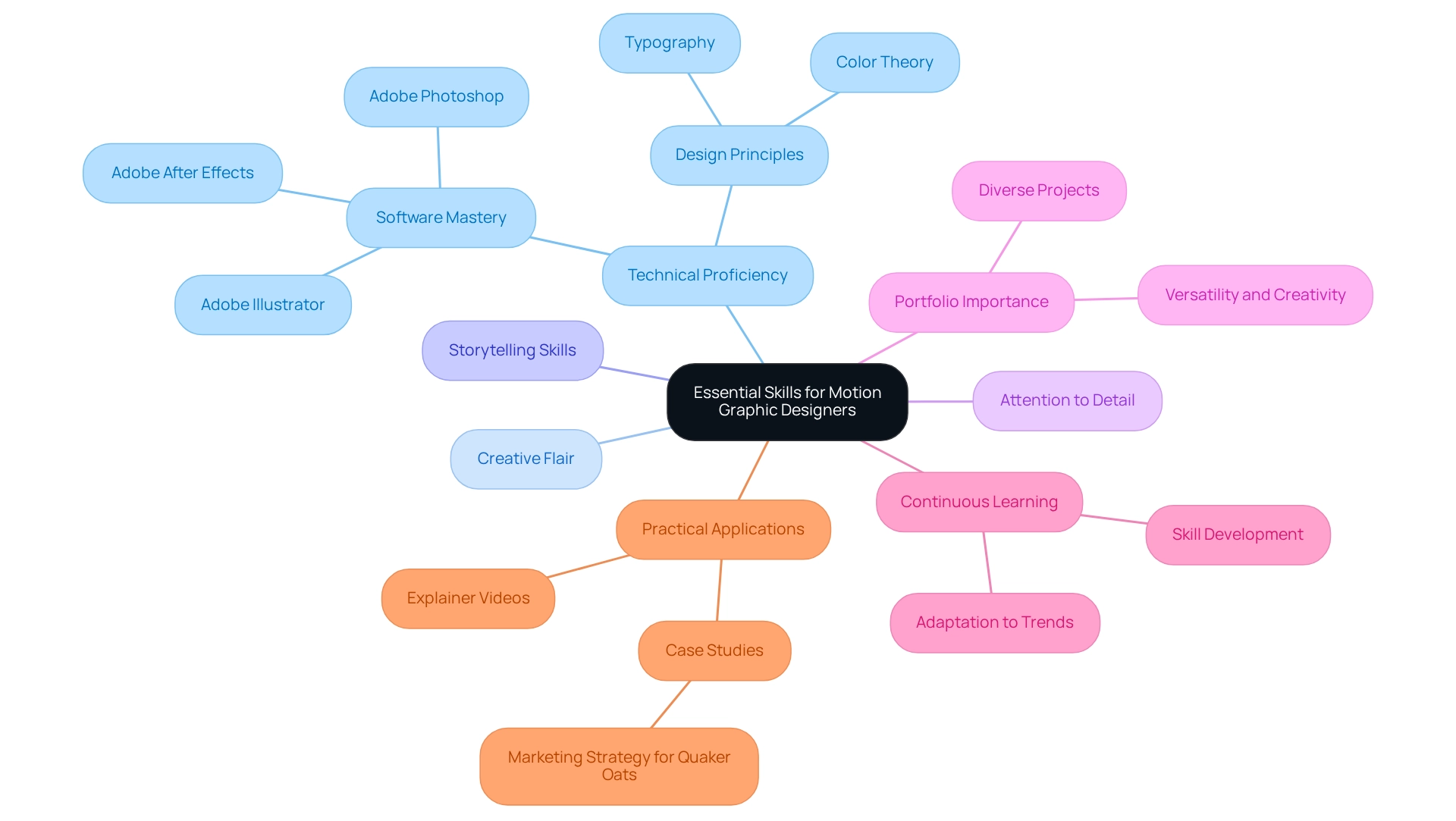
Factors Influencing Motion Graphic Designer Salaries
The salary for motion graphic designers is influenced by a multitude of factors, including experience level, geographic location, industry, and project complexity. Entry-level creatives typically earn between $35,000 and $45,000 annually, while mid-level specialists can expect salaries ranging from $50,000 to $75,000. As professionals accumulate experience, their earning potential increases significantly, with senior roles in motion graphic design often commanding salaries well above $75,000, particularly in high-demand markets.
According to Salary.com, the salary for motion graphic designers reflects these trends, offering a comprehensive breakdown across various percentiles.
Geographic location is a pivotal factor in salary variations for motion graphic designers. In major urban centers such as San Francisco or New York, salaries for these positions frequently exceed $100,000, driven by the high cost of living and intense competition for skilled professionals. This compensation information underscores the value attributed to their expertise.
The industry also plays a critical role in determining salaries for motion graphic designers. Those employed in sectors like entertainment or advertising, where the demand for high-quality animated visuals is pronounced, generally enjoy higher compensation compared to their counterparts in less dynamic fields. Moreover, specialized skills, particularly in 3D animation or visual effects, can further elevate salaries, as these competencies are increasingly sought after in the digital landscape.
The median compensation for web developers and digital creators stands at $92,750, providing a valuable reference point for understanding the earnings landscape for animation artists.
A recent case study highlights the challenges visual artists face in balancing creative processes with the fast-paced demands of social media projects. Acknowledging the time required for creative work and fostering a supportive work environment can significantly aid in attracting and retaining top talent in this field. As Chris Jung aptly states, “Making shit move” transcends the final product; it encompasses a respect for the creative journey that leads to impactful designs.
This respect for the creative process is essential, as it directly correlates with job satisfaction and retention in a competitive market.
In summary, the salary for motion graphic designers is shaped by a combination of experience, location, industry, and specialized skills. Understanding these components, along with the advantage of possessing a versatile skill set that includes video editing and visual effects expertise, is vital for both aspiring professionals and employers aiming to attract top talent in a competitive landscape.
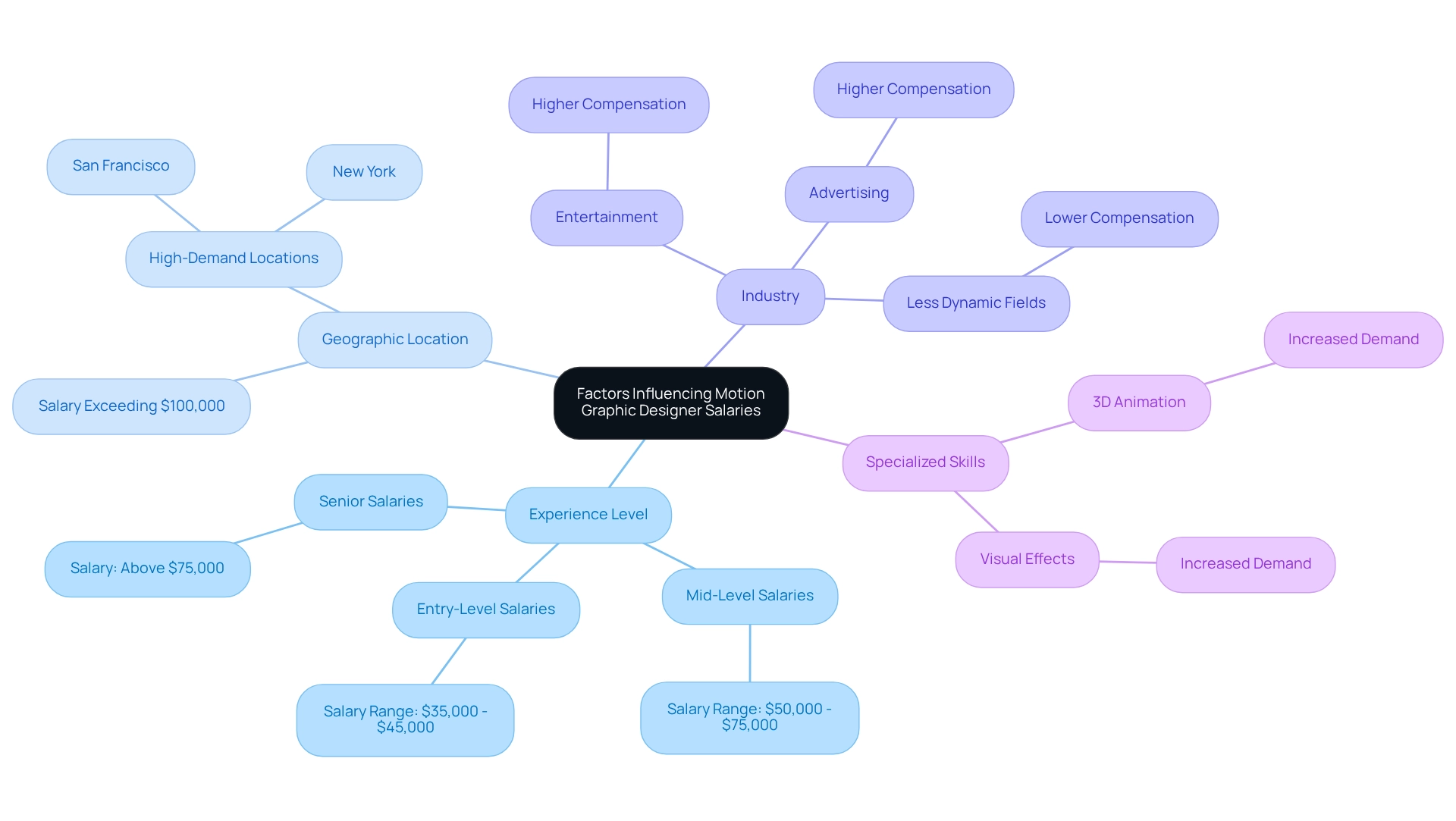
Salary Trends for Motion Graphic Designers: A Historical Perspective
In the past decade, creators of animated visuals have experienced a remarkable surge in earnings, underscoring the increasing demand for video content across diverse platforms. In 2015, the average salary for motion graphic designers was approximately $50,000; by 2025, this figure is projected to rise to about $70,000. This upward trend can be primarily attributed to the expansion of digital marketing strategies, the proliferation of social media, and the growing importance of visual storytelling in advertising campaigns.
Notably, Glassdoor reports that the salary for motion graphic designers starts at $52,012 annually, providing a comparative framework for understanding this income growth.
Moreover, the North American animation sector, home to renowned studios such as Disney, Pixar, and DreamWorks Animation, has significantly contributed to this trend, continuing to thrive and expand. Since 2020, the production of TV animation has been increasing at a rate of 4% year-over-year, driven by viewer preferences and the rise of streaming services. As companies increasingly prioritize high-quality video content to engage their audiences, the demand for skilled animators is expected to remain robust, potentially resulting in higher salaries for motion graphic designer positions in the years ahead.
This trend emphasizes the critical role that animators play in shaping effective marketing narratives and the overall branding landscape. For instance, WonderEight’s extensive campaign for Quaker Oats illustrates how talented visual creators can deliver powerful branding experiences, highlighting their significance within the industry.
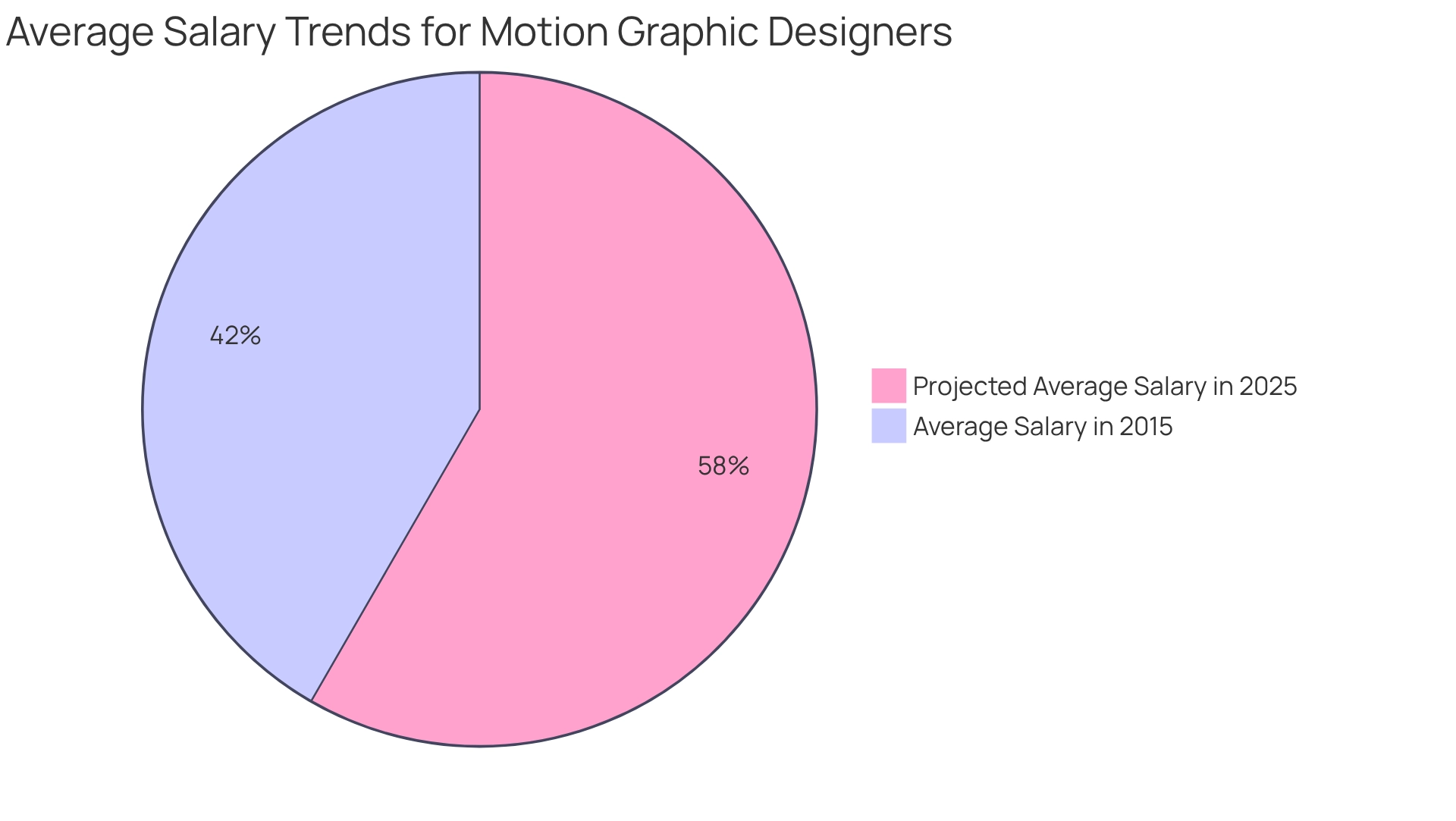
Comparative Salaries: Motion Graphic Designers vs. Related Professions
In the realm of design, professionals engaged in moving visuals typically earn higher salaries in motion graphic designer roles compared to conventional visual artists. However, they often earn less than specialized positions such as 3D animators and visual effects creators. For instance, the average income for a visual designer in the Northwest Colorado nonmetropolitan region is approximately $71,840, while conventional design artists earn around $55,000. In contrast, 3D animators can command salaries exceeding $80,000, reflecting the advanced technical skills and expertise required in their field.
This salary disparity underscores the increasing demand for engaging visual content across various sectors, which has elevated the value of animation design skills in the job market. As companies strive to enhance their brand visibility through captivating multimedia, the role of animated visuals creators becomes increasingly vital. Gaining work experience and building a robust portfolio are essential steps toward achieving success as a visual artist.
Moreover, a recent analysis of income across visual design roles reveals that:
- UX specialists lead the pack with earnings nearing $130,000
- Motion graphic designers follow closely at $120,000
- Brand identity specialists earn about $80,000
- Web specialists receive $60,000
- Print specialists receive $50,000
- Entry-level visual artists start at approximately $40,000
This illustrates the potential for advancement as one gains experience and develops a strong portfolio.
As the saying goes, “The details are not the details. They make the design,” highlighting the significance of meticulousness in this field. Case studies further underscore the necessity of visual design skills, particularly when juxtaposed with 3D animators.
For example, the extensive campaigns crafted for brands such as Miranda and Quaker Oats showcase the practical application of these skills. They illustrate how sectors evolve and the demand for talented individuals capable of creating engaging visual narratives continues to rise, positioning visual design as a lucrative career path for aspiring creators.
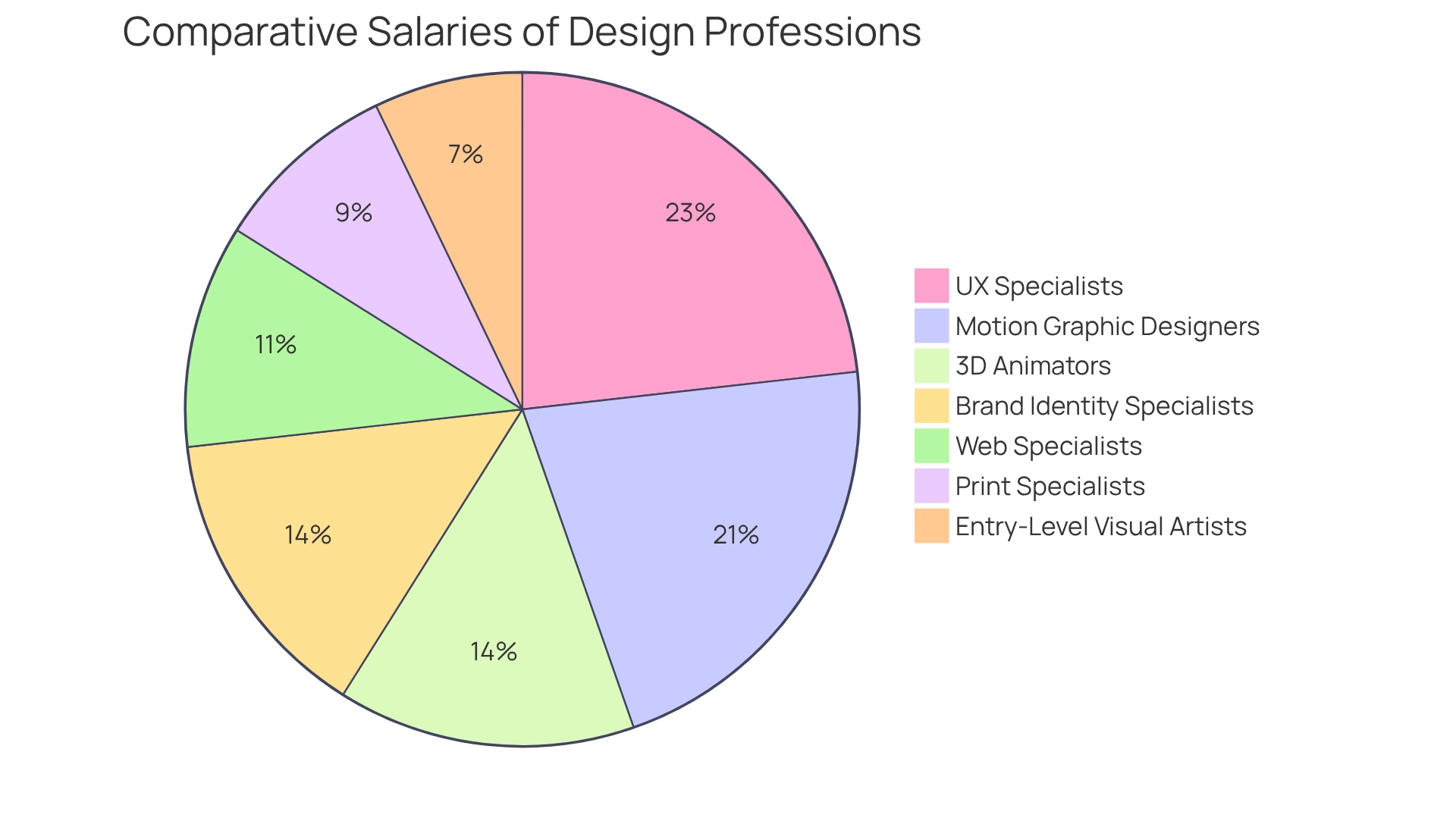
Beyond Salary: Benefits and Perks for Motion Graphic Designers
Beyond competitive salaries, animated visuals creators often appreciate a diverse array of advantages and perks that significantly enhance their overall compensation package. Common offerings include health insurance, retirement plans, and paid time off, which are essential for job security and well-being. According to Brad Author, approximately 50-60% of motion graphics professionals are employed in full-time roles, particularly within large corporations and production studios, underscoring the stability and benefits associated with these positions.
Numerous organizations also prioritize adaptable working arrangements, enabling creative professionals to maintain a healthy work-life balance, a factor that has been shown to positively impact job satisfaction.
Opportunities for professional growth constitute another vital element, allowing creatives to stay current with industry trends and technologies. Access to the latest design software and tools is frequently provided, ensuring that creators can deliver high-quality work efficiently. The projected growth of visual artists from 2023 to 2033 is anticipated to be between 3% and 5%, indicating a promising future for individuals in this profession.
For independent workers, the landscape varies somewhat. They typically command higher hourly rates and possess the freedom to select projects that align with their interests and expertise. However, they may lack access to traditional benefits, which can influence their overall financial stability.
Despite this, the flexibility and independence associated with freelance work can lead to heightened levels of job satisfaction. Overall, these additional advantages and benefits are crucial in enhancing job satisfaction and financial well-being for visual artists, particularly regarding the salary for motion graphic designers. This profession is not only rewarding in terms of income but also in terms of overall quality of life. The successful campaigns executed for brands such as Miranda and Quaker Oats further illustrate the impact of effective branding and marketing strategies, emphasizing the essential role of visual artists in achieving measurable results.
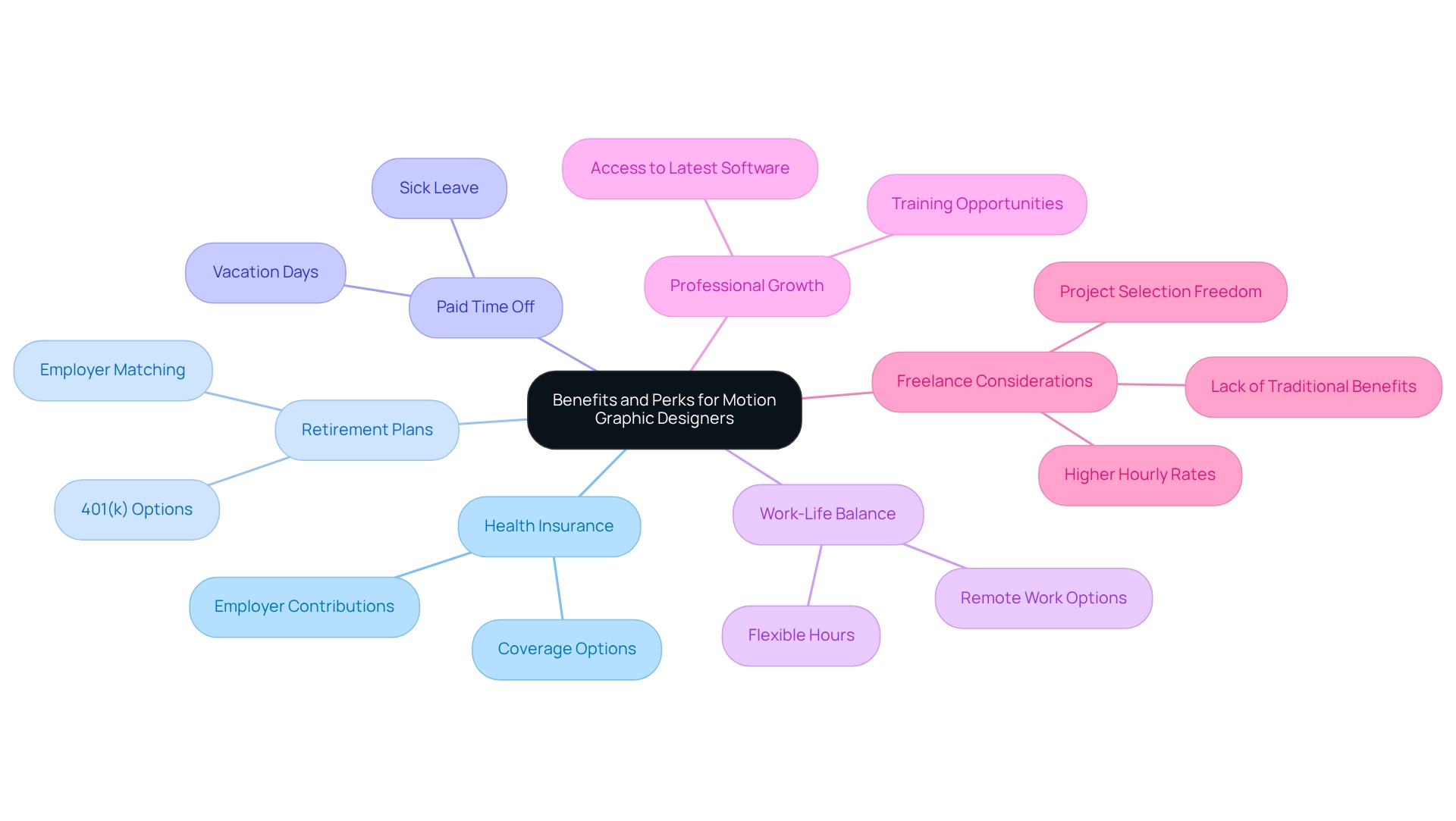
Frequently Asked Questions About Motion Graphic Designer Salaries
Frequent inquiries regarding visual creator compensation often underscore starting-level remuneration, regional influences on income, and the trajectory of earnings growth over time. Entry-level salaries for motion graphic designer positions typically range from $35,000 to $45,000 annually. However, in high-demand markets such as New York or San Francisco, motion graphic designers can see salaries approach around $50,000.
As creators accumulate experience and hone specialized skills, they frequently witness substantial pay increases; mid-level professionals can command salaries ranging from $50,000 to $75,000 for motion graphic designer roles. Understanding these compensation dynamics is crucial for aspiring creators as they establish realistic expectations and set informed career objectives.
Geographic location significantly impacts salary variations for motion graphic designers. For example, those working in urban areas with a high concentration of media and entertainment firms tend to earn higher salaries due to the increased demand for their expertise. This trend highlights the importance of considering location when assessing potential earnings within the industry.
Moreover, the potential for income growth remains promising. As designers progress in their careers, they often undertake more complex projects and assume leadership roles, which can lead to higher salaries. Insights from career coaches suggest that continuous skill enhancement and networking within the industry are vital strategies for maximizing earnings growth.
Additionally, the Motion Graphics Certificate at Noble Desktop presents educational opportunities that can influence income expectations.
However, visual artists often face pressure to deliver results swiftly, which can conflict with the more gradual creative process. This challenge may affect compensation dynamics and overall job satisfaction. Understanding the percentile wage estimate, where the median wage represents the 50th percentile, provides clearer insight into the salary ranges and expectations for motion graphic designers.
A notable case study is Chris Jung’s work on MTV’s logo sting, where his contributions in concept, design, and animation revitalized the logo sting, enhancing viewer experience prior to shows. This exemplifies practical applications of animated design and its potential impact on professional advancement and earnings. As Chris Jung articulates, “Making things move,” emphasizing the artistic essence of animated design and its relevance in salary discussions.
By comprehending these factors, aspiring motion graphic designers can more effectively navigate their career paths and make informed decisions regarding their professional development.
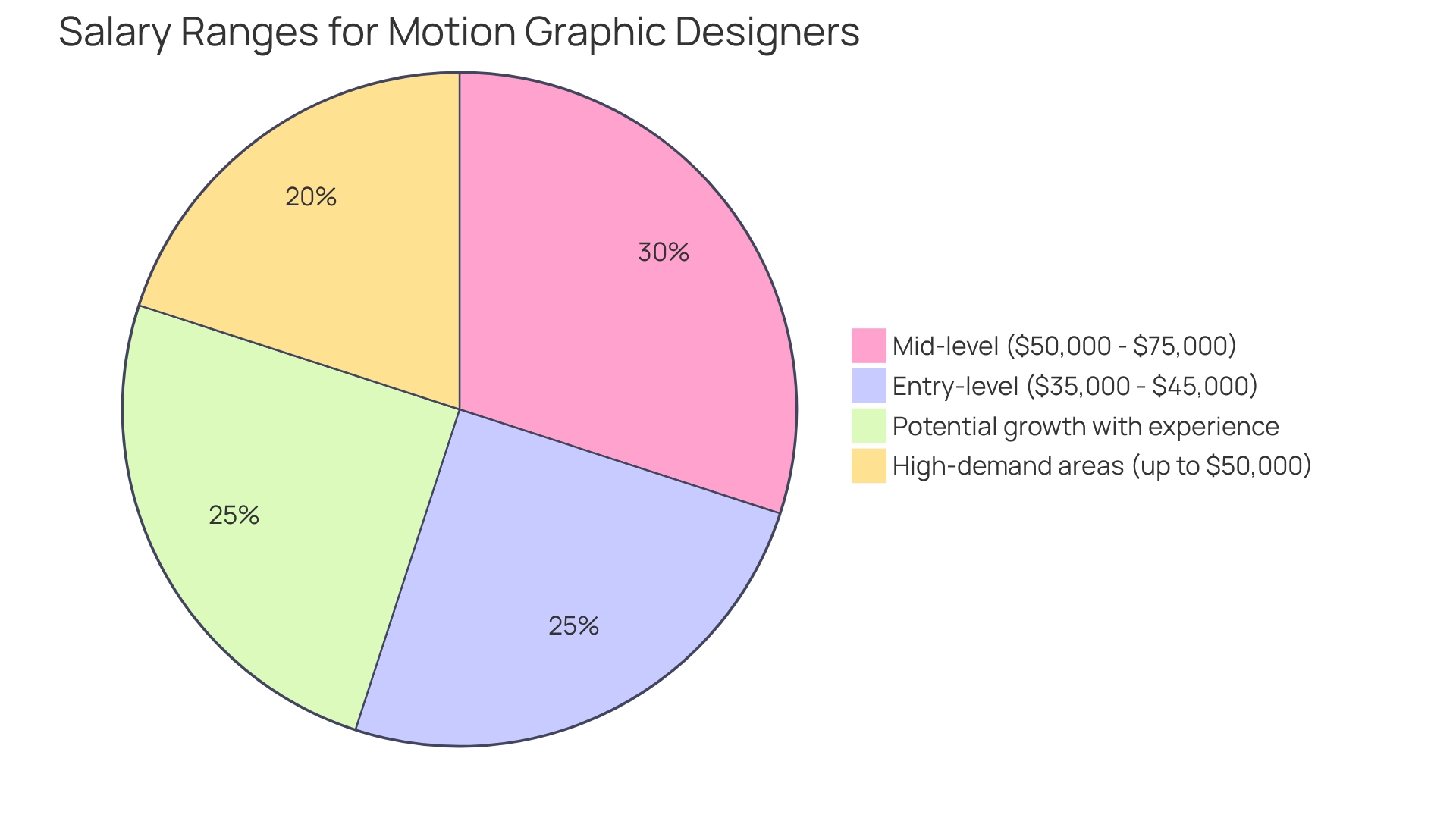
Conclusion
The profession of motion graphic design stands as a cornerstone of modern marketing and storytelling, merging creativity with technical expertise. Motion graphic designers adeptly transform static images into dynamic animations that engage and resonate with audiences. Their skills are increasingly indispensable across various sectors, particularly in advertising, where striking visuals significantly bolster brand messaging and enhance consumer engagement.
The financial outlook for motion graphic designers is robust, with salaries reflecting the surging demand for their expertise. Entry-level positions offer competitive starting wages, while seasoned professionals can command higher salaries, particularly in metropolitan areas and specialized sectors. This upward trajectory in compensation underscores the profession’s expanding significance in the digital landscape, fueled by the escalating need for high-quality video content and effective visual communication.
Furthermore, the benefits and perks associated with careers in motion graphic design play a pivotal role in job satisfaction and overall quality of life. From comprehensive health insurance to flexible working arrangements, these advantages highlight the value placed on creative professionals within the workforce. As the industry continues to evolve, the skills and capabilities of motion graphic designers will remain essential in crafting impactful narratives and driving brand success.
In essence, a career in motion graphic design not only offers financial rewards but also presents an opportunity to influence the future of visual storytelling. As businesses increasingly acknowledge the power of animated content, this profession is poised for continued growth, providing aspiring designers with the chance to make a significant impact in a vibrant and creative field.
Frequently Asked Questions
What is the role of an animated visuals creator?
An animated visuals creator is a creative expert who produces animated visuals and visual effects for various media, including film, television, and digital platforms. They combine design principles with animation techniques to create captivating content that enhances storytelling.
What software do animated visuals creators typically use?
Animated visuals creators commonly use sophisticated software such as Adobe After Effects, Cinema 4D, and Adobe Premiere Pro to transform still images into dynamic representations.
How do animators contribute to marketing?
Animators play a crucial role in marketing, particularly in advertising. Studies show that 35.1% of marketers believe animation helps visualize concepts better, which enhances audience engagement.
What are the economic opportunities for motion graphic designers?
The average annual salary for motion graphic designers in the Northwest Colorado nonmetropolitan region is $71,840, indicating significant economic opportunities in this sector.
How is the demand for animated design expected to change in the future?
The demand for skilled visual artists is expected to escalate as brands increasingly leverage animated content to convey messages and evoke emotions, particularly as we approach 2025.
What skills are essential for visual creators?
Essential skills for visual creators include proficiency in CAD, desktop publishing, image editing, video production, and web development applications, as well as a strong understanding of animation principles, typography, and color theory.
Why is a strong portfolio important for visual artists?
A well-rounded portfolio is important for job seekers in this domain as it showcases versatility and creativity, often serving as a compelling substitute for formal education.
What is the significance of storytelling in animated visuals?
Strong storytelling skills are vital for transforming complex concepts into captivating visual narratives, ensuring that every element of a project serves the overarching message.
How do explainer videos utilize animated visuals?
Explainer videos use animated visuals to simplify complex ideas and processes, enhancing audience engagement and conversion rates, as demonstrated in successful marketing strategies like those developed for Quaker Oats.



